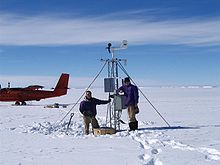
Back Estació meteorològica automàtica Catalan Estación meteorológica automática Spanish Estazio meteorologiko automatiko Basque Station météorologique automatique French Automatska meteorološka postaja Croatian 자동기상관측장비 Korean Automatyczna stacja meteorologiczna Polish Estação meteorológica automática Portuguese 自動氣象站 Chinese

An automatic weather station (AWS) is an automated version of the traditional weather station, either to save human labor or to enable measurements from remote areas.[1] An AWS will typically consist of a weather-proof enclosure containing the data logger, rechargeable battery, telemetry (optional) and the meteorological sensors with an attached solar panel or wind turbine and mounted upon a mast. The specific configuration may vary due to the purpose of the system.[1] The system may report in near real time via the Argos System, LoRa and the Global Telecommunications System,[2] or save the data for later recovery.[3]
In the past, automatic weather stations were often placed where electricity and communication lines were available. Nowadays, the solar panel, wind turbine and mobile phone technology have made it possible to have wireless stations that are not connected to the electrical grid or hardline telecommunications network.[4]
One of the main advantages of an automatic weather station is that it can provide accurate and reliable weather data in remote, inaccessible or hazardous locations. The AWS can be programmed to alert authorities in case of severe weather events.
- ^ a b King, Jeremy. "Automatic Weather Stations". Archived from the original on 22 May 2009. Retrieved 2009-04-15.
- ^ "About the Automatic Weather Station project". Automatic Weather Station project. The National Science Foundation Office of Polar Programs. Archived from the original on February 4, 2009. Retrieved 2009-04-15.
- ^ "ADDI Automatic weather stations". ADDI. Archived from the original on 2009-03-26. Retrieved 2009-04-15.
- ^ Cite error: The named reference
ABMwas invoked but never defined (see the help page).